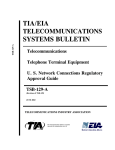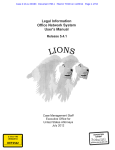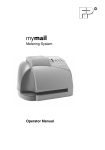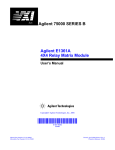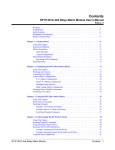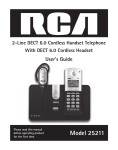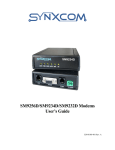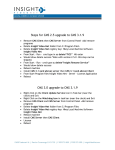Download Customer Information - Administrative Council for Terminal
Transcript
Administrative Council for Terminal Attachments (ACTA) Customer Information Revision: July 2003 Background: The Administrative Council for Terminal Attachments (“ACTA”) has revised its Customer Information1 to remove a perceived restriction on the connection of certain terminal equipment to the Public Switched Telephone Network (“PSTN”) and certain private-lines services. The major changes were to the Alarm Dialing Equipment section. The Customer Information contained in this document (Consumer Information, Revision: July 2003), has been adopted by ACTA and may be used immediately for terminal equipment approvals at the Responsible Party’s discretion. As the ACTA-adopted Consumer Information, Revision: July 2003, is intended to replace Consumer Information, Revision: March 2002, effective January 1, 2005, all Telephone Terminal Equipment (“TTE”) approved for connection to the PSTN and certain private-line services requiring such approval shall provide the Consumer Information contained herein. As of September 1, 2002, Telephone Terminal Equipment (“TTE”) approved for connection to the Public Switched Telephone Network (“PSTN”) and certain private-lines services, pursuant to 47 CF R §68.218(b)(1), must include ACTA-adopted Consumer Information. Customer Information: The following customer information must be provided to customers with each unit of approved terminal equipment. Please note that there are differences in the information required for simple consumer products, coin/credit card phones, systems, digital equipment and various other categories of equipment. Wherever possible example wordings that meet the requirement have been provided. Text in [Italics] is product or manufacturer specific information. If the equipment is being approved by the Telecommunications Certification Body (“TCB”) process, a copy of the required customer information must be provided to the TCB. These materials must be identical to what is provided to the customer. While the information specified here must be provided to the customer, Responsible Parties have the option of either providing that information in printed form, or in whatever alternative form the user manual is provided. Alternative methods include disk, CD-ROM, or via the 1 The Customer Information in this document was originally prepared by the Telecommunications Industry Association’s (“TIA”) Committee TR-41.11 and subsequently adopted by the Administrative Council for Terminal Attachments (“ACTA”) as a requirement for TTE compliance with Part 68. Customer Information 1 July 2003 Internet. The goal is to make sure the information is readily available to users while minimizing the burden on manufacturers. It is sometimes the practice to ship product in large quantities (bulk) from the manufacturer to a distributor or reseller without customer instructions. This is acceptable as long as the required information accompanies each unit shipped to the end customer. General Requirements For All Equipment: a) For equipment approved after July 23, 2001, include the following paragraph: This equipment complies with Part 68 of the FCC rules and the requirements adopted by the ACTA. On the [insert location of the label] of this equipment is a label that contains, among other information, a product identifier in the format US:AAAEQ##TXXXX. If requested, this number must be provided to the telephone company. For equipment approved prior to July 23, 2001, include this paragraph: This equipment complies with Part 68 of the FCC rules. On the [insert location of the label] of this equipment is a label that contains, among other information, the FCC registration number and ringer equivalence number (REN) for this equipment. If requested, this information must be provided to the telephone company. b) List all applicable certification jack Universal Service Order Codes (“USOC”) for the equipment. For some types of analog and digital systems, list associated Facility Interface Codes (“FIC”) and Service Order Codes (“SOC”). These are required when the customer orders service from the local telephone company. Refer to Alliance for Telecommunications Industry Solutions (“ATIS”) Technical Report No. 5 for a more extensive listing of jack configurations and their designations (e.g., RJ11C), or refer to the Telcordia NC/NCITM Decoder for a full listing. c) State that for single and two-line equipment that connects to the telephone network via a plug and jack, the plug and jack used with this equipment must comply with FCC Part 68 rules. Use words similar to the following: A plug and jack used to connect this equipment to the premises wiring and telephone network must comply with the applicable FCC Part 68 rules and requirements adopted by the ACTA. A compliant telephone cord and modular plug is provided with this product. It is designed to be connected to a compatible modular jack that is also compliant. See installation instructions for details. d) Explain the Ringer Equivalence Number (or REN) and its use. Note: RENs are associated with loop-start and ground-start ports. Do not use for E&M or digital ports. Use words similar to the following: The REN is used to determine the number of devices that may be connected to a telephone line. Excessive RENs on a telephone line may result in the devices not ringing in response to an incoming call. In most but not all areas, the sum of RENs should not exceed five (5.0). To be certain of the number of devices that may be connected to a line, as determined by the total RENs, contact the local telephone company. For products approved after July 23, 2001, the REN for this product is Customer Information 2 July 2003 part of the product identifier that has the format US:AAAEQ##TXXXX. The digits represented by ## are the REN without a decimal point (e.g., 03 is a REN of 0.3). For earlier products, the REN is separately shown on the label. e) Provide information on what will happen if this equipment causes harm to the telephone network. Use words similar to the following: If this equipment [insert identity of equipment] causes harm to the telephone network, the telephone company will notify you in advance that temporary discontinuance of service may be required. But if advance notice isn't practical, the telephone company will notify the customer as soon as possible. Also, you will be advised of your right to file a complaint with the FCC if you believe it is necessary. f) Provide information on what will happen if the telephone company makes changes that could affect this equipment. Use words similar to the following: The telephone company may make changes in its facilities, equipment, operations or procedures that could affect the operation of the equipment. If this happens the telephone company will provide advance notice in order for you to make necessary modifications to maintain uninterrupted service. g) State what to do if there are problems with this equipment. Do not say to return to dealer as dealers can change. Use words similar to the following: If trouble is experienced with this equipment [insert identity of equipment], for repair or warranty information, please contact [company name or service center in the U.S.A. and phone number]. If the equipment is causing harm to the telephone network, the telephone company may request that you disconnect the equipment until the problem is resolved. h) Explain which repairs, if any, the customer (user) can perform. If there is a section in the general customer instructions that provides detailed information on repairs, a reference to that section is acceptable. If this equipment is of a type that is not intended to be repaired, state that fact in place of any repair instructions. i) State that this equipment must not be used on party lines. Use words similar to the following: Connection to party line service is subject to state tariffs. Contact the state public utility commission, public service commission or corporation commission for information. j) Include a caution to users who may have alarm dialing equipment. Use words similar to the following: If your home has specially wired alarm equipment connected to the telephone line, ensure the installation of this [equipment ID] does not disable your alarm equipment. If you have questions about what will disable alarm equipment, consult your telephone company or a qualified installer. k) If this equipment uses a telephone handset, state that it is hearing aid compatible. Use words similar to the following: Customer Information 3 July 2003 This equipment is hearing aid compatible. Customer-Owned Coin/Credit Card Phones: The instructions that are provided with each customer-owned coin or credit card phone must include the following notice: To comply with state tariffs, the telephone company must be given notification prior to connection. In some states, the state public utility commission, public service commission or corporation commission must give prior approval of connection. Data Equipment: For permissive, programmable and (or) fixed loss loop operation data equipment, in addition to the general requirements for all equipment, information must be provided explaining which jack is associated with each operation. − − − − Permissive, use RJ11C Programmable, use RJ41S and RJ45S Fixed Loss Loop, use RJ41S Refer to ATIS Technical Report No. 5 for details on these connectors. For Private (Leased) Line (Analog Data Format) equipment, the type JM8 jack is required. Refer to ATIS Technical Report No. 5 for details on this connector. For Private (Leased) Line (Digital Format) equipment, in addition to the general requirements for all equipment, certain digital connections require that an encoded analog content and billing protection affidavit be provided the telephone company. Customer instructions must contain information on the preparation and submission of the affidavit. Private (Leased) Lines For Analog Services: The Facility Interface Code (FIC) associated with each private line application represents the type of service that will be provided by the telephone company. The user instructions must contain a detailed list of private line ports and the associated FICs for which the equipment has been approved. In addition, the Service Order Code (SOC) must also be included for analog systems. The SOC indicates the degree of network protection provided by the equipment. For some details on applicable FICs and SOCs refer to section 2b above. Note: Some services may not be available in all locations. Systems: The consumer instructions for systems must contain information on all connectors to the network (switched and private line). This information includes the jack USOCs, FlCs, SOCs, the REN if applicable, the premises wiring information, and any affidavits or written authority authorizations. Furthermore, the US:AAAEQ##TXXX number of the system must be provided so the telephone service provider can ascertain intended modes of operation and verification of certification ports. Adjuncts - KX and PX Devices: The consumer information must contain notification that when the adjunct is used with a leased system, permission of the owner of the equipment must be obtained for connection of the adjunct because modification of the host system is often required. Customer Information 4 July 2003 Customer instructions for KX type telephones with medium impedance analog message waiting lights and/or line status indicators must contain statements that they can only be connected to host equipment and never directly to the network. The reason is that they do not meet the 5 megohm requirement and most likely will create excessive leakage current when polled by the telephone company's daily automatic loop insulation test equipment. Such events trigger a maintenance action by the telephone company to determine the location of such leakage currents. OEM Devices: When approved equipment such as couplers or modems are furnished to the OEM market (final equipment assemblers), the consumer instructions must contain the following information: The mounting of the approved unit in the final assembly must be made so that the approved unit is isolated from exposure to any hazardous voltages within the assembly. Adequate separation and restraint of cables and cords must be provided. The circuitry from the approved unit to the telephone line must be provided in wiring that carries no other circuitry (such as PC or PR leads) unless specifically allowed by the rules. PC board traces carrying tip and ring leads shall have sufficient spacing to avoid surge breakdown. Information shall be provided as to the power supply source requirements, signal levels, etc., as applicable. Information shall be provided that when the approved device is enclosed in an assembly, and not readily accessible, that the approval label shall be placed on the exterior of the cabinet for each type of approved device contained therein. Information shall be provided which states that the final assembler shall provide in the consumer instructions all applicable customer information. A modular plug or jack shall be provided which complies with TIA/EIA-IS-968 Chapter 6 requirements for dimensions, tolerances and metallic plating. Automatic Dialers: The consumer instructions for automatic dialers must contain the following cautionary notice: WHEN PROGRAMMING EMERGENCY NUMBERS AND(OR) MAKING TEST CALLS TO EMERGENCY NUMBERS: 1) Remain on the line and briefly explain to the dispatcher the reason for the call. 2) Perform such activities in the off-peak hours, such as early morning or late evenings. Toll Restriction and Least Cost Routing Equipment: The consumer/purchaser/supplier instructions accompanying this equipment and/or software features of systems must contain the following notice: Customer Information 5 July 2003 The software contained in [insert specific equipment type or features] to allow user access to the network must be upgraded to recognize newly established network area codes and exchange codes as they are placed into service. Failure to upgrade the premises systems or peripheral equipment to recognize the new codes as they are established will restrict the customer and the customer's employees from gaining access to the network and to these codes. Equipment With Direct Inward Dialing (“DID”): The consumer/purchaser/supplier instructions accompanying the equipment and/or features of systems with direct inward dialing (DID) interfaces, must contain the following: ALLOWING THIS EQUIPMENT TO BE OPERATED IN SUCH A MANNER AS TO NOT PROVIDE FOR PROPER ANSWER SUPERVISION IS A VIOLATION OF PART 68 OF THE FCC'S RULES PROPER ANSWER SUPERVISION IS WHEN: A. This equipment returns answer supervision to the public switched telephone network (PSTN) when DID calls are: − − − − Answered by the called station Answered by the attendant Routed to a recorded announcement that can be administered by the customer premises equipment (CPE) user. Routed to a dial prompt B. This equipment returns answer supervision on all DID calls forwarded to the PSTN. Permissible exceptions are: − A call is unanswered − A busy tone is received − A reorder tone is received Equal Access Requirements: If equipment such as private branch exchanges (PBXs), key systems or customer-owned coin/credit card telephones is sold to a call aggregator, it must be capable of providing the end user equal access to the carrier of the user's choice. The customer instructions for such equipment must contain the following wording: This equipment is capable of providing users access to interstate providers of operator services through the use of access codes. Modification of this equipment by call aggregators to block access dialing codes is a violation of the Telephone Operator Consumers Act of 1990. Electrical Safety Advisory: Parties responsible for equipment requiring AC power should consider including an advisory notice in their customer information suggesting the customer use a surge arrestor. Telephone companies report that electrical surges, typically lightning transients, are very destructive to customer terminal equipment connected to AC power sources. This has been identified as a major nationwide problem. Customer Information 6 July 2003 Equipment With FAX Capability: The Customer Information for facsimile (FAX) equipment must contain the following wording: The Telephone Consumer Protection Act of 1991 makes it unlawful for any person to use a computer or other electronic device, including FAX machines, to send any message unless such message clearly contains in a margin at the top or bottom of each transmitted page or on the first page of the transmission, the date and time it is sent and an identification of the business or other entity, or other individual sending the message and the telephone number of the sending machine or such business, other entity, or individual. (The telephone number provided may not be a 900 number or any other number for which charges exceed local or long-distance transmission charges.) In order to program this information into your FAX machine, you should complete the following steps: [Insert here instructions for programming the equipment and the required information or the page where it can be found]. These requirements apply to all FAX machines, and have been extended to all FAX modems manufactured on or after December 13, 1995. Alarm Dialing Equipment: Alarm dialing equipment (equipment code "AL") includes dialers associated with fire and intrusion protection systems, medical alert systems, equipment failure notification systems, and similar event reporting systems. The critical nature of such equipment calls for clear installation instructions so that the equipment will operate as intended. In addition, customers must have clear testing instructions in order to verify proper operation after installation. The customer information requirements for alarm dialing equipment vary depending upon whether the equipment has "Line Seize" capability and whether that capability is provided by a properly installed RJ31X or RJ38X jack or by utilizing a functionally-equivalent arrangement. Definitions. For the purpose of these customer information requirements, the following definitions are applicable. Line Seize capability - A feature of some alarm dialing equipment that allows the equipment to disconnect other equipment connected to the same phone line and initiate an event reporting call even when other equipment (telephone, answering system, computer modem, etc.) on the same line is being used. Functionally Equivalent arrangement - Equipment and wiring that provides Line Seize capability without the use of an RJ31X or RJ38X jack, i.e., it allows the alarm dialing equipment to disconnect other equipment connected to the same phone line and initiate a call even when the other equipment is in use. Requirements. The customer information accompanying alarm dialing equipment shall include installation instructions, testing instructions, notice (a) below and one additional notice from (b), (c), or (d) below, whichever is applicable. a) Notice For All Alarm Dialing Equipment For all alarm dialing equipment, provide a cautionary notice advising that the equipment must be installed according to manufacturer instructions in order to ensure proper operation and must be tested according to manufacturer instructions immediately after installation, and periodically thereafter, in order to verify proper operation. Use words similar to the following: Customer Information 7 July 2003 Caution - To ensure proper operation, this equipment must be installed according to the enclosed installation instructions. To verify that the equipment is operating properly and can successfully report an alarm, this equipment must be tested immediately after installation, and periodically thereafter, according to the enclosed test instructions. b) Notice for Equipment with Line Seize Capability using an RJ31X or RJ38X Jack For alarm dialing equipment with Line Seize capability by means of an RJ31X or RJ38X jack, provide a cautionary notice that the RJ31X or RJ38X jack must be installed correctly in order for the Line Seize feature to work properly when other equipment connected to the same line is in use. Use words similar to the following (where RJ38X may be used in place of RJ31X, if appropriate, and the name and/or model number of the equipment may be substituted for the term “alarm dialing equipment” in the text and figure): Caution - In order for "alarm dialing equipment" to be able to seize the phone line to report an alarm or other event when other customer equipment (telephone, answering system, computer modem, etc.) connected to the same line is in use, "alarm dialing equipment" must be connected to a properly installed RJ31X jack. The RJ31X jack must be connected in series with, and ahead of, all other equipment attached to the same phone line. Series installation of an RJ31X jack is depicted in the figure below. If you have any questions concerning these instructions, you should consult your telephone company or a qualified installer about installing the necessary jack and alarm dialing equipment for you. Network Service Provider's Facilities Customer Premises Equipment and Wiring Computer RJ31X Jack Alarm Dialing Equipment Unused RJ-11 Jack Telephone Line Telephone Network Demarcation Point Unused RJ-11 Jack Fax Machine Telephone Answering System Telephone c) Notice for Equipment Utilizing A Functionally Equivalent Arrangement to Provide Line Seize Capability For alarm dialing equipment that provides Line Seize capability by means of a functionally equivalent arrangement as defined above, provide a cautionary notice that the equipment must be installed according to manufacturer instructions in order for the alarm dialing equipment to work properly when other equipment connected to the same line is in use. Use words similar to the following: Caution - Verification of Line Seize capability should be made immediately after installation, and periodically thereafter, in order to ensure that this equipment can initiate Customer Information 8 July 2003 a call even when other equipment (telephone, answering system, computer modem, etc.) connected to the same line is in use. d) Notice for Alarm Dialing Equipment without Line Seize Capability For alarm dialing equipment without Line Seize capability, provide a cautionary notice advising that the equipment is not able to report an alarm when other equipment connected to the same line is in use. Use words similar to the following: Caution - This equipment cannot report an alarm when other equipment (telephone, answering system, computer modem, etc.) connected to the same phone line is in use. End Consumer Information Revision: July 2003 Customer Information 9 July 2003









